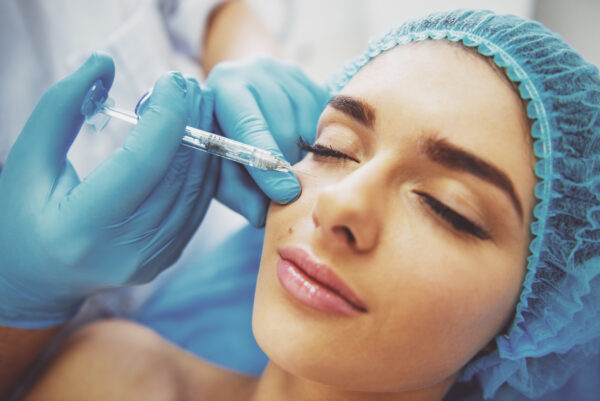
Injectable fillers for the face are a relatively new dental specialty. In addition to the standard dental care, some dentists now provide injectable fillers made of hyaluronic acid gel and botulinum toxin type A. You can employ these chemicals for aesthetic enhancements (e.g., the treatment of fine lines and wrinkles) or address oral issues like TMJ (temporomandibular joint condition). Facial injections are most well-known for the latter use. Depending on the laws in each state, dental hygienists can get training to give face injections, which can satisfy patients’ desires for self-improvement through cosmetic dentistry and be a lucrative source of extra revenue for dental offices. An extra 12-18 months of study beyond that of a hygienist’s undergraduate degree are required for LPN certification.
The dental applications of botulinum toxin type A include the treatment of TMJ problems, bruxism, clenching, and hypertrophy of the masseter muscle. Nasolabial folds, radial lip lines, and a high lip line are just a few of the aesthetic dental issues that can be treated by this technique. Restoring lost volume in the skin and other soft tissues, the hyaluronic acid gel can help you seem years younger. Fine wrinkles and nasolabial folds can be treated, lips can be enhanced, facial tissue can be contoured, sunken scars can be made to be less noticeable, and the volume of gingival tissue can be increased interproximally to prevent black triangles between teeth.
After administration, there is always a chance of unwanted side effects, just like with any other kind of injection. When injected, the hyaluronic acid gel can cause swelling, soreness, discomfort, and bruising at the injection site. Botulinum toxin type A can cause side effects such as facial nerve palsy, discomfort at the injection site, flu-like symptoms, nontargeted muscular weakening, dysphasia, and hematoma. Similarly, there are situations in which face injections shouldn’t be used. Active infection at or near the injection site, as well as a history of allergy to hyaluronic acid or the lidocaine in the syringe, are all reasons to avoid hyaluronic acid gel. The filler shouldn’t be put into places either that don’t have enough blood flow. Pregnancy, breastfeeding, neuromuscular illnesses, motor neuron diseases, concomitant use of aminoglycosides, and sensitivity to toxins are all situations in which botulinum toxin type A should be avoided.
Healthcare providers with the appropriate training and certification can inject botulinum toxin type A and hyaluronic acid gel. These include licensed practical nurses (LPNs), dentists (DDS or DMDs), RNs, MDs, DOs, NPs, and PAs. After completing their respective degrees, the aforementioned healthcare professionals are required to take either a weekend-long course in botulinum toxin type A and hyaluronic acid gel injections or a full-day course in a related subject. This supplementary training typically costs between $1,500 and $2,000.
To give botulinum toxin type A and hyaluronic acid gel face injections, a registered or licensed dental hygienist must undergo additional training in addition to their existing credentials. A dental hygienist must first become a licensed practical nurse, a process that can take anywhere from 12 months to two years. After earning the needed education, aspiring PNs must demonstrate their competence by passing the National Council Licensure Examination for Practical Nurses (NCLEX-PN).
A dentist who wants to increase his or her earnings may decide to pay for a dental hygienist’s further training to become a licensed practical nurse. A licensed practical nurse (LPN) must complete extra training in botulinum toxin type A and hyaluronic acid gel injections, consisting of a lab session and classroom instruction, before administering these treatments to patients.
Each state’s dental practice statute and the judgment of the state’s dentistry board determine whether or not botulinum toxin type A and dermal fillers can be administered in a dental clinic.
Implementation in Practice
Dental practitioners, such as dental hygienists, can get certified to provide these injections in the oral and maxillofacial regions only after completing the necessary educational components. Aside from dentists, dental firms may employ other medical experts who have obtained certification to give facial injections. As was previously indicated, dentists may opt to invest in the expenditures of further training for dental hygienists so that they may become licensed to provide facial injections, thereby increasing the dental practice’s revenue. Furthering one’s education might make a dental hygienist more marketable in the profession.
There has been a significant uptick in the use of hyaluronic acid gel and botulinum toxin type A injections in private dentistry practices. These facial injections can be utilized to treat both cosmetic and functional dental issues caused by muscle degeneration. As soft-tissue injections gain popularity, it is envisaged that they will be used for a wider range of services connected to the oral and maxillofacial regions, such as the treatment of functional issues, while they are now only employed for cosmetic purposes. As a result, dental hygienists should think about the importance of their work in this field and consider extending their education.
Benefits of Services on a Dental Practice’s Revenue
Adding these procedures to an already successful business might increase earnings. Botulinum toxin type A costs around $12 per unit to administer, with an injection needing anywhere from 2–4 units. Most hyaluronic acid gel cartridges will set you back around $500. Injections of botulinum toxin type A or hyaluronic acid gel may require more than one syringe, and the number of units needed to achieve the desired effect may range from five to ten, depending on the region or areas being treated.
The frequency of injections is usually every six months, but it might vary from patient to patient. The frequency of hygiene patients’ follow-up visits is typically set at every six months.
Consequently, it’s worth noting that patients can get their face injections at the same time they get their teeth cleaned. The clinic may have to add time to the session if patients receive both treatments at once, but they will earn more money in less time.







